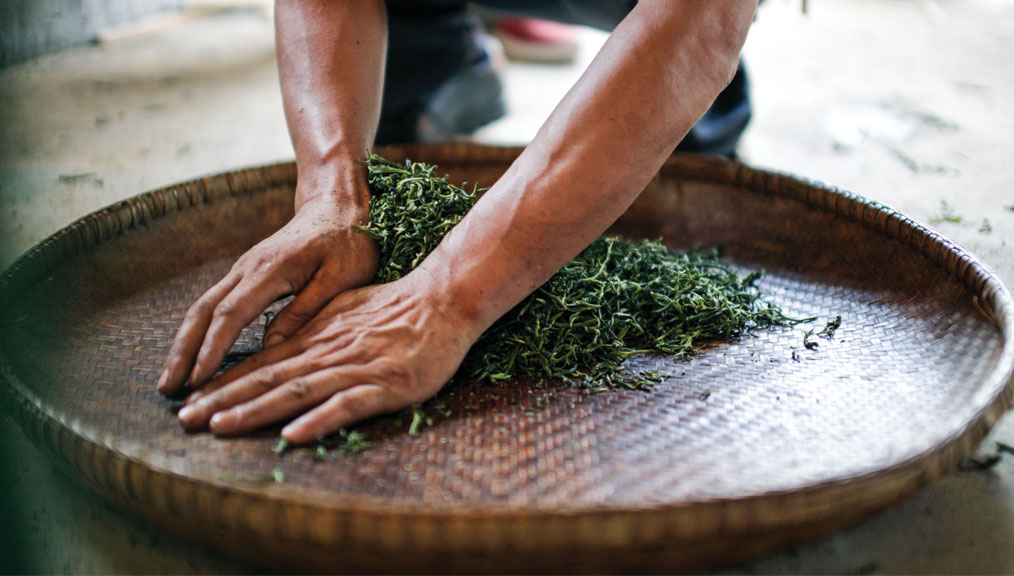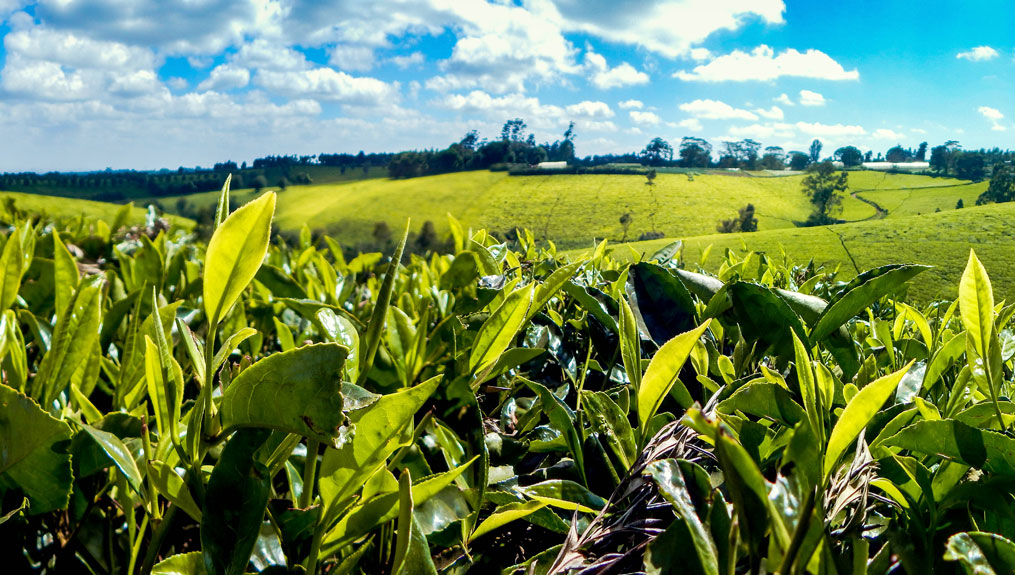(Photo: courtesy of Xian Chan Tea, Inc. D.B.A. Teabook.)
[A]ll Chinese tea comes from the same parent plant, Camellia sinensis. How leaves are processed, their region of origin, and picking time dictate how tea will look and taste in the cup. Tea varieties are also distinguished by the part of the plant that’s picked, the extent of oxidation, and how leaves might be dried or aged.
Green Tea
Green tea is the least oxidized of the five Chinese tea types; it spends the shortest amount of time exposed to air after picking. Full leaves (sometimes a bud) of the Camellia sinensis var. sinensis plant are picked for green tea—these leaves can be young, whole, or mature. To minimize oxidation, a “kill green” process is employed through heat application. Tea producers might use a wok to heat the leaves for a short time, or they might roll and bake them. Pan-firing or hot air drying is most common, as it enhances the leaves’ aroma and brightness.
Brew temperature: 170–185 degrees Fahrenheit.*
Flavor notes: vegetal, mild, cleansing, and sometimes even savory or buttery.
Predominant growing regions: China’s Hunan, Zhejiang, and An Hui provinces.
White Tea
White tea leaves are also lightly oxidized, often dried by light pan-firing to stop the oxidation process. These leaves are usually gathered in the first pluck of spring or pre-spring. Both leaves and young buds are gathered, which often contain mao, or tiny fine hairs, yielding a cup that’s light and delicate. The three most common genres of white tea are white peony, silver needle, and Shoumei. Because it’s low in tannins and gentle on the stomach, white tea is considered the most neutral tea, appropriate for all body types.
Brew temperature: 185–195 degrees Fahrenheit.*
Flavor notes: subtle and delicate with soft hints of natural sweetness, sometimes reminiscent of melon.
Predominant growing regions: China’s Hunan, Zhejiang, and Fujian provinces.
Oolong
Oolong tea production is more complex than other tea, its range of flavors most broad. The skills of the teamaker impart a unique flavor in each oolong tea, including steps like sun withering, indoor withering, rolling, roasting, and drying. This tea is typically composed of two leaves and a bud of the Camellia sinensis plant, yielding more material to work with than other tea types. In the withering process, leaves are heaped much like a compost pile, withered much longer than green or white teas. As a result, oxidation can range from 15 to 80 percent. Oolong is rarely astringent and lends itself to the sweeter end of the flavor spectrum.
Brew temperature: 185–195 degrees Fahrenheit.*
Flavor notes: widest range of distinct flavor profiles; known to have very complex flavors similar to figs or plums, often with great depth and roundness.
Predominant growing regions: China’s Fujian province; Taiwan.
Red Tea
Americans typically refer to red tea as “black.” Like green tea, red tea is made from young or fully mature leaves. Red tea processing follows six main steps: leaves are picked, withered, rolled, allowed to rest, heat-dried, and finished. Following these steps, leaves are characterized by hints of red and gold. A more aggressive rolling and shaping process facilitates oxidation levels up to 90 percent; however, red tea is never fully oxidized, as this results in a leaf covered in golden fuzz.
Brew temperature: 185–205 degrees Fahrenheit.*
Flavor notes: often robust, woodsy, or toasted; may have notes of walnut, raisin, and chocolate.
Predominant growing regions: China’s Fujian, Yunnan, and Hunan provinces.
Pu-erh Tea
Pu-erh comes from Camellia sinensis var. assamica, found in China’s Yunnan province. Tea producers pick young or mature leaves from the assamica plants, then leave them in the sun to dry. After drying, the leaves are steamed to loosen their structure, usually molded into a cake form. The cakes are then fermented, catalyzed by enzymes found within the tea leaves. Aging periods range up to thirty years and beyond. Raw pu-erh uses traditional aging methods, while ripe pu-erh is subject to an accelerated fermentation, characterized by a high-humidity wet-piling process conducted in a factory environment (much like a controlled compost pile).
Brew temperature: 185–205 degrees Fahrenheit.*
Raw pu-erh flavor notes: younger cakes are astringent, woodsy, nutty, and pungent; aged cakes are smooth, smoky, and sweet.
Ripe pu-erh flavor notes: earthy, mushroom, and mellow flavors with a sweet, lingering aftertaste.
Predominant growing regions: China’s Yunnan province.
*Brewing temperatures are recommended for most teas within each category.
—Jeffrey McIntosh is a regular contributor and owner of Teabook.














